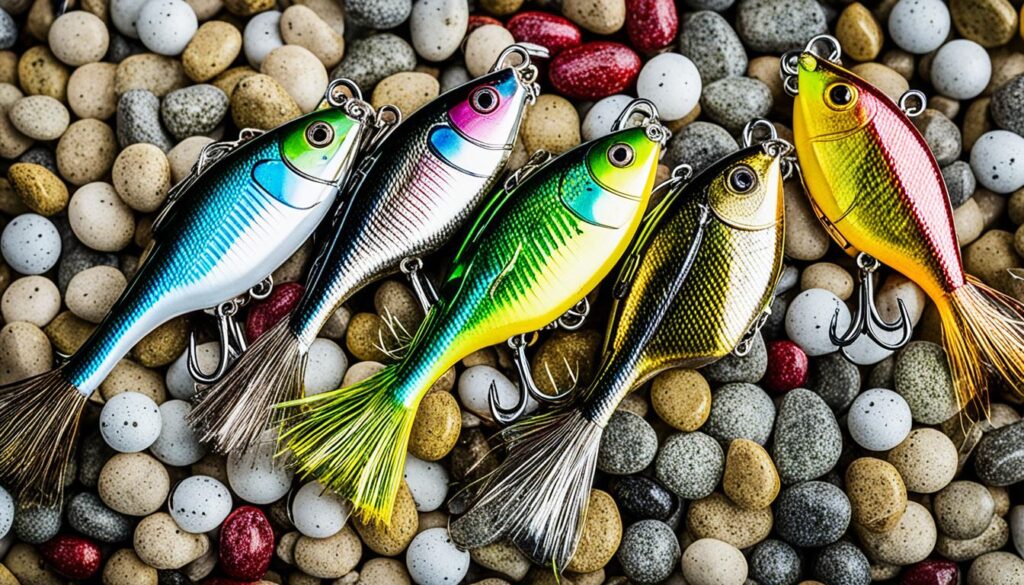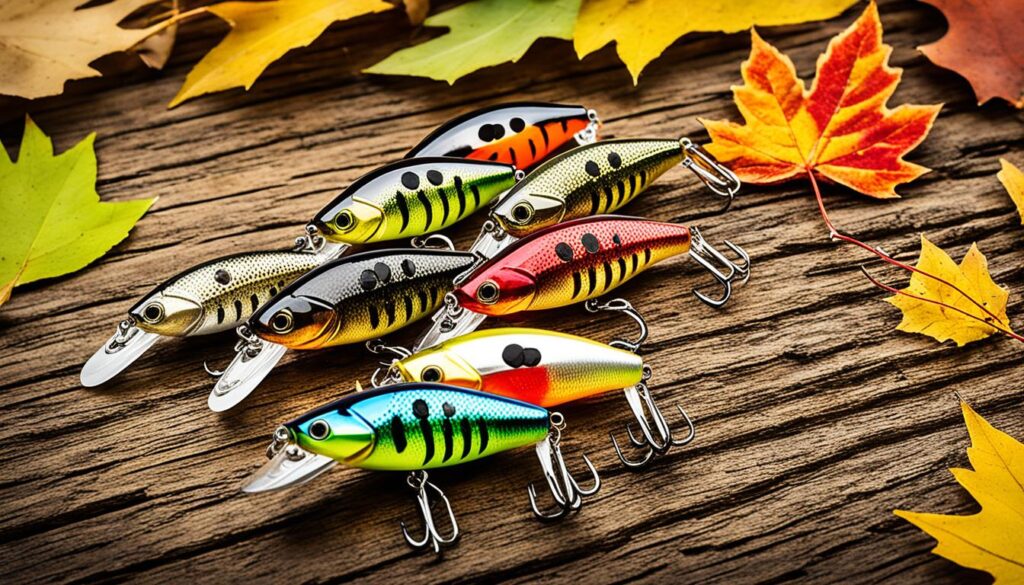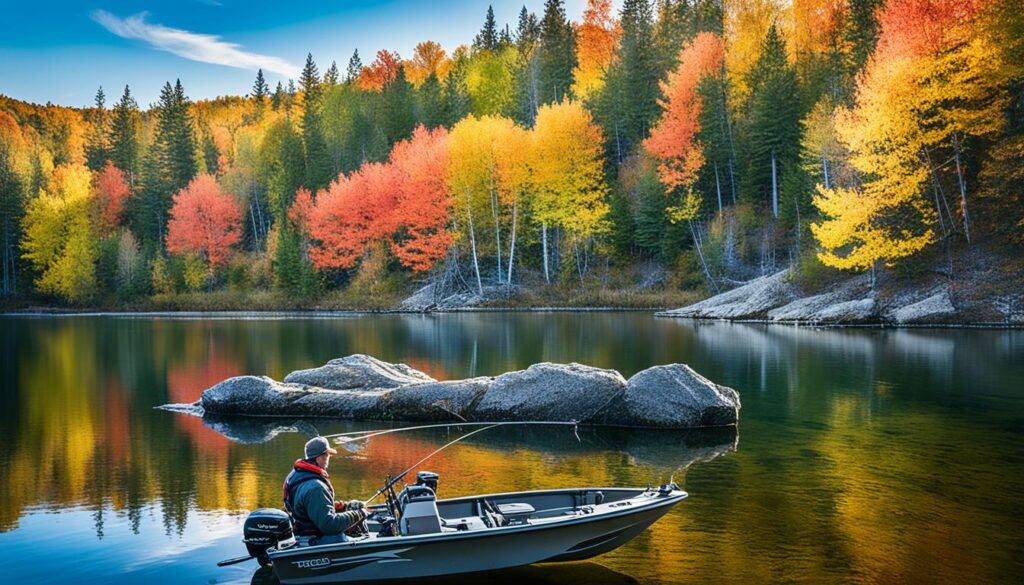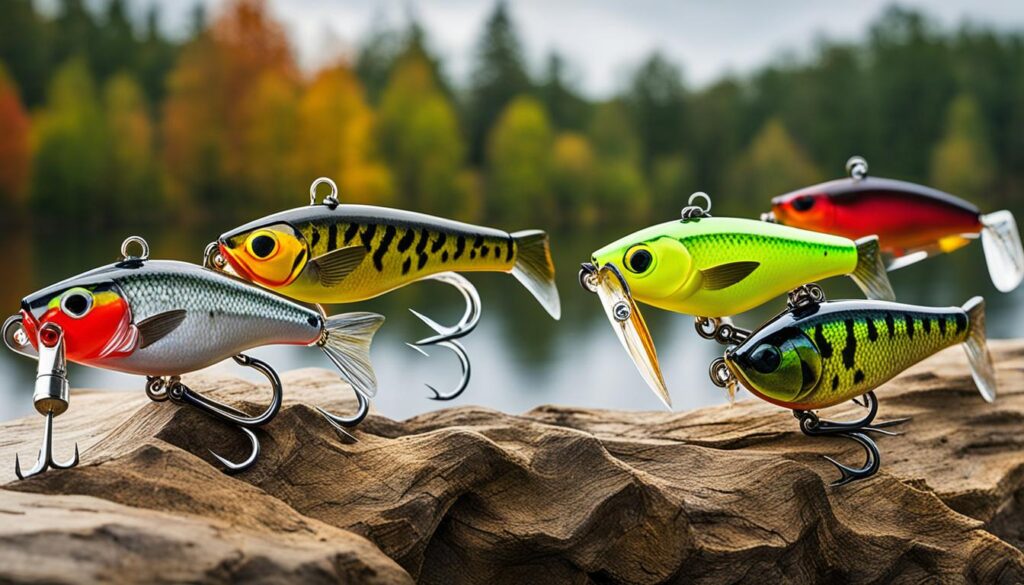Fall is a fantastic time to target bass, and one effective technique for catching them is flipping. As an experienced angler, I recommend focusing on isolated cover such as grass clumps and hard cover like docks, rocks, logs, and stumps. Flipping cover tends to excel during the brightest hours of the day, but there can also be productive periods in the morning, lunchtime, and evening.
For flipping vegetation, I suggest using a 7-10 heavy flipping stick with a 6-pound braid. And for wood, docks, and hard targets, a 7-6 heavy flipping stick with 20-25-pound fluorocarbon is ideal. As for lures, I highly recommend using Zoom Z Craw baits in various sizes and colors based on the fish’s preference.
Key Takeaways:
- Fall is a great time to target bass using the flipping technique.
- Focus on isolated cover and hard structures.
- Flipping tends to be most productive during the brightest hours of the day.
- Use a 7-10 heavy flipping stick with 6-pound braid for vegetation and a 7-6 heavy flipping stick with 20-25-pound fluorocarbon for wood and hard targets.
- Zoom Z Craw baits in various sizes and colors are recommended lures.
Targeting Ragged Edges for Fall Bass
In the fall, as grass beds break apart in colder waters, targeting the ragged edges can be a productive strategy for catching big bass. I’ve learned this technique from experienced pro angler Jimmy Mason, who focuses on these areas where the bass tend to follow the baitfish. Greg Hackney, another successful angler, also finds the ragged edges of grass mats to be highly productive. These areas create contour features that allow bass to set up and ambush their prey.
To effectively target these ragged edges, using crankbaits specifically designed for fall bass fishing can be highly effective. These crankbaits are built to imitate the behavior and appearance of the forage in the fall, enticing bass to strike. By utilizing these specialized baits, you can increase your chances of success and reel in some trophy-worthy fish.
When targeting the ragged edges, it’s important to pay attention to the movement of the baitfish. Bass will often position themselves strategically to take advantage of these natural feeding opportunities. By casting your crankbaits along the edges and retrieving them with erratic movements, you can mimic the behavior of injured or fleeing baitfish, triggering aggressive strikes from bass lurking in the area.
“Targeting the ragged edges of grass mats can be a game-changer in fall bass fishing. It’s all about locating those feeding areas where bass are keying in on prey. Using the right crankbaits designed for fall conditions can make a world of difference.” – Jimmy Mason, Pro Angler
The Buzzbait Approach for Fall Bass
When fall bass are actively feeding and chasing bait schools, using a buzzbait can be a highly effective approach. As a seasoned angler, I recommend incorporating buzzbaits into your fall bass fishing arsenal. These lures create a surface disturbance that mimics baitfish, enticing aggressive strikes from bass.
For stable weather conditions, I suggest using a 1/4-ounce or 1/2-ounce buzzbait. This size allows for effective casting and retrieves while still attracting the attention of bass. However, after cold fronts or during tougher fishing conditions, downsizing to a 1/8-ounce buzzbait can be more successful. The smaller size imitates the smaller shad that bass are often feeding on during the fall.
When using a buzzbait, it’s important to equip yourself with the right gear. I recommend using a spinning rod paired with braided line for longer casts and better control. The braided line provides the strength needed to horse bass out of grassy areas if necessary. Remember to experiment with your retrieve speed to find what works best on any given day.
Overall, incorporating buzzbaits into your fall bass fishing strategy can yield impressive results. Keep in mind that bass behavior can vary, so adapt your tactics to fish activity and environmental conditions. By staying flexible and using proven techniques, you’ll increase your chances of landing trophy-sized bass.
Strategies for Fall Bass Fishing
Fall bass fishing can be unpredictable, but there are strategies that can increase your chances of success. One approach is to mix up your bait selection to match the changing forage and to avoid using baits that fish have seen too often.
“When it comes to fall bass fishing, variety is key,” says pro angler John Smith. “I like to keep a selection of top crankbaits for fall bass and other lures that mimic the natural prey in the water.”
By offering different baits with unique colors, sizes, and actions, you can trigger a reaction from bass and entice them to strike. Fall bass are often on the hunt for a solid meal before winter sets in, so using lures that resemble their primary forage can be highly effective.
Fall Bass Fishing Lure Selection
To maximize your chances of success, it’s important to have a range of top-rated bass crankbaits and other fall bass fishing lures in your tackle box. The best fall crankbaits are typically those that imitate the seasonal forage, such as shad or crawfish. Popular choices include:
- Zara Spook topwater bait
- Strike King Squarebill crankbait
- Zoom Super Fluke soft plastic jerkbait
- Jig and pig combo
- Spinnerbait with a willow blade
Experimenting with different lure types and colors can help you dial in on what the bass are responding to on any given day. Remember to vary your retrieval speed and depth to find the sweet spot for triggering bites.
Fishing Prominent Habitat Features
During slower periods, targeting prominent habitat features can make a big difference in fall bass fishing. Fishing isolated rock, stumps, points, and bluffs can often yield good results.
“I always look for key areas that offer cover, structure, and easy access to deep water,” says professional angler Jane Johnson. “These are the high percentage spots where bass are more likely to be holding.”
Focusing on these areas can help you locate active bass and increase your chances of hooking up. To effectively target these habitat features, consider using jigs, drop-shot rigs, Ned rigs, and Texas rigs. These presentations can be effective in enticing bites from fall bass.
| Habitat Feature | Recommended Baits |
|---|---|
| Isolated Rock | Jig with a matching trailer |
| Stumps | Texas rig with a soft plastic crawfish imitator |
| Points | Drop-shot rig with a finesse worm |
| Bluffs | Ned rig with a small stick bait |
Remember to adjust your presentation based on water clarity, weather conditions, and the behavior of the bass. Being versatile and adaptable in your approach will increase your chances of success on the water.

With the right strategies and lure selection, you can make the most of your fall bass fishing adventures. Keep experimenting, try different techniques, and enjoy the thrill of hooking into big bass during this exciting season.
Adjusting to Fall Bass Behavior
Fall is an exciting time for bass fishing, but it’s important to understand that bass behavior can vary depending on conditions. As an angler, it’s crucial to adjust your tactics accordingly to increase your chances of success.
If you find that the bass are being finicky or the wind is strong, consider making a small adjustment to your buzzbait. Try removing the skirt and replacing it with a soft jerkbait. This will provide a different look and increase your chances of hooking fish that may be more hesitant to strike. By offering a subtle presentation, you can entice bites from even the most cautious bass.
During non-active or post-frontal conditions, bass tend to be less aggressive. In such situations, it’s best to slow down your presentation. Techniques like jigs, Texas rigs, and other bottom-oriented baits can be highly effective. These slower presentations allow bass more time to evaluate and strike your bait, increasing your chances of a successful hookup.
Another crucial factor to consider when adjusting to fall bass behavior is matching your bait size to the primary forage in the body of water you’re fishing. By using baits that closely resemble the natural prey of the bass, you can create a more realistic presentation and trigger more strikes. Take the time to observe the baitfish in the area and select baits that closely imitate their size and color.
Fall bass behavior can be unpredictable, but by adapting your tactics to the conditions and the fish’s preferences, you can significantly increase your chances of success. Remember to be patient and willing to experiment with different presentations until you find what works best on any given day.
| Fall Bass Behavior | Adjustments |
|---|---|
| Bass are being finicky or wind is strong | Remove skirt from buzzbait, replace with soft jerkbait |
| Non-active or post-frontal conditions | Slow down presentation with jigs, Texas rigs, and bottom-oriented baits |
| Bait size matching primary forage | Observe baitfish and select baits that closely resemble their size and color |
Making the Most of Bite Windows
Bite windows, or periods of increased feeding activity, are key opportunities for catching fall bass. These windows can occur at first light, sundown, during windy conditions, or during an afternoon warmup. It’s important to stay alert for signs of baitfish activity, such as flipping, splashing, or birds clustering near the surface.
During bite windows, using a variety of moving baits can be effective in triggering reactive bites from actively feeding fish. Some top options for fall bass fishing lures include:
- Topwaters: These lures create commotion on the water’s surface and can imitate wounded baitfish or frogs. They are especially effective during low-light conditions such as early mornings or late evenings.
- Spinnerbaits: With their flashy blades and enticing action, spinnerbaits are excellent choices for covering water quickly and enticing reaction strikes from bass.
- Bladed jigs: Also known as vibrating jigs or chatterbaits, these baits produce a unique vibration that can trigger aggressive strikes from bass.
- Jerkbaits: These suspending or slow-sinking lures can be twitched or jerked to imitate injured baitfish, attracting the attention of hungry bass.
Using these top fall fishing crankbaits can help you capitalize on bite windows and increase your chances of hooking into actively feeding bass.
As the image shows, these crankbaits come in various shapes, sizes, and colors, allowing you to match the prevailing forage and preferences of the bass in your fishing area. Experiment with different presentations and retrieve speeds to find the most effective technique for triggering bites.
If you notice signs of increased baitfish activity during bite windows, don’t miss the chance to present these enticing lures to fall bass. Remember to vary your retrieves and adapt to the conditions to entice aggressive strikes and maximize your catch.
Fall Bass Fishing Techniques
In addition to the tactics mentioned earlier, there are other fall bass fishing techniques worth considering. By diversifying your approach, you can increase your chances of success and maximize your catch.
Big, Slow Baits: Paddletail Swimbaits
During the fall and coldwater period, using big, slow baits like paddletail swimbaits can be incredibly effective. These larger baits provide a substantial meal for bass and can trigger aggressive strikes. The slow, realistic swimming action of paddletail swimbaits entices bass and offers an irresistible target. By mimicking the natural movement of baitfish, these baits can tempt even the most wary fall bass.

The Alabama Rig and Double Fluke Rig
When you want to imitate a bait cluster and increase your chances of catching multiple fish, the Alabama rig and double fluke rig are go-to techniques. The Alabama rig consists of multiple swimbaits or flukes rigged together to resemble a school of baitfish. This presentation can elicit aggressive responses from fall bass that are actively feeding. Similarly, the double fluke rig involves rigging two flukes or other soft plastics on a single hook, creating a larger, more enticing bait cluster. Experiment with different colors to find what the bass in your area are keying in on.
Both the Alabama rig and double fluke rig offer versatility and the ability to cover water quickly. They allow you to imitate a group of feeding baitfish, triggering a predatory response from bass in the area. These techniques can be particularly effective when targeting larger bass that are searching for a substantial meal as they prepare for the winter months.
Remember to adjust your presentation to match the behavior and preferences of the fish in the body of water you’re fishing. By incorporating these fall bass fishing techniques into your arsenal, you’ll be well-equipped to tackle the challenges of autumn angling and increase your chances of landing trophy-sized bass.
| Technique | Description |
|---|---|
| Big, Slow Baits: Paddletail Swimbaits | Large, realistic swimbaits with a slow, natural swimming action |
| The Alabama Rig | Multiple swimbaits or flukes rigged together to resemble a school of baitfish |
| Double Fluke Rig | Two flukes or soft plastics rigged together to imitate a bait cluster |
Targeting Prominent Habitat Features
During slower periods or when bite windows are not present, targeting prominent habitat features can be a successful approach to fall bass fishing. Isolated rock formations, stumps, secondary points, bluffs, matted vegetation, pads, and the shadow pockets behind overhanging trees are all prime examples of features that can hold fall bass. These areas provide cover and shelter for bass, making them ideal feeding and ambush spots.
To effectively target these habitat features, I recommend using a variety of presentations such as flipping jigs, Texas rigs, football jigs, and Carolina rigs. These baits allow you to work the targeted areas thoroughly, enticing bass to strike. Choosing the right plastic baits and colors that imitate bream and crawfish can significantly increase your chances of enticing bites from bass.
When selecting your bait, consider the size and pattern that closely resembles the local forage in the body of water you’re fishing. By closely mimicking the natural prey, you’re more likely to fool the bass and trigger strikes. Experiment with different color combinations and retrieve speeds to find what works best in your specific fishing location.
Table: Prominent Habitat Features and Recommended Baits
| Habitat Feature | Recommended Baits |
|---|---|
| Isolated Rocks | Flipping Jigs, Texas Rigs |
| Stumps | Football Jigs, Texas Rigs |
| Secondary Points | Football Jigs, Carolina Rigs |
| Bluffs | Football Jigs, Carolina Rigs |
| Matted Vegetation | Flipping Jigs, Texas Rigs |
| Pads | Flipping Jigs, Texas Rigs |
| Shadow Pockets | Flipping Jigs, Texas Rigs |
By targeting these prominent habitat features and using the recommended baits, you can increase your chances of landing fall bass. Remember to vary your presentation and adapt to the specific conditions of the fishing location. Stay observant and adjust your tactics as needed to maximize your success on the water.

Fall Bass Fishing Tips
When targeting fall bass, it’s important to stay sharp and be prepared to switch tactics as needed. Schooling fish can be found throughout the day, so having a fast-moving bait like a spinnerbait or a swim jig on hand can allow you to capitalize on spontaneous schooling activity. Even when fishing slower presentations, keeping a reaction bait handy can help you locate fish and entice bites. Remember to take advantage of any bite window opportunities and be patient during slower periods when bass may be less active.
Fall bass fishing can be exciting and challenging, but with the right strategies and techniques, you can increase your chances of success. To help you make the most of your fall bass fishing experience, here are some valuable tips:
- Be adaptable: Fall bass behavior can change rapidly, so be prepared to switch up your tactics and adjust your bait selection as needed. Pay attention to the fish’s response and adapt accordingly.
- Utilize fast-moving baits: Schooling fish are common during the fall, so having fast-moving baits like spinnerbaits and swim jigs can help you capitalize on these opportunities.
- Keep a reaction bait handy: Even when the fish are less active, having a reaction bait like a crankbait or a jerkbait can help you locate fish and trigger bites.
- Take advantage of bite windows: Bite windows, or periods of increased feeding activity, are key opportunities for catching fall bass. Pay attention to signs of baitfish activity and be ready to capitalize on these windows.
- Stay patient: Bass may be less active during slower periods, so it’s important to be patient and persistent. Slow down your presentation and focus on enticing bites with techniques like jigging and finesse fishing.
By following these tips, you’ll be well-equipped to tackle fall bass fishing and increase your chances of landing a trophy-worthy catch.
Fall Bass Fishing Equipment
Having the right equipment is crucial when targeting fall bass. Whether you’re flipping vegetation or targeting wood and docks, choosing the right gear can make a significant difference in your success. Here are some essential items you should have:
- A 7-10 heavy flipping stick with a 6-pound braid is ideal for flipping vegetation. This setup provides the strength and sensitivity needed to reel in bass hiding in thick cover.
- For wood, docks, and hard targets, a 7-6 heavy flipping stick with 20-25-pound fluorocarbon is recommended. This combination offers the power and durability required to handle larger fish and navigate through structures.
- When it comes to selecting baits, consider using Zoom Z Craws or buzzbaits. These lures come in various sizes and colors, allowing you to experiment and match the fish’s preferences and the forage in the water.
- Additionally, it’s essential to have a variety of baits and presentations in your tackle box. Fall conditions can be unpredictable, so having different options will ensure you’re prepared to adapt to changing conditions and fish behavior.
Remember, the right equipment is just one piece of the puzzle. Pair it with the right techniques, adjust to fish behavior, and target prominent habitat features to increase your chances of landing that trophy-worthy fall bass.
Conclusion
Fall bass fishing offers an exciting and rewarding experience for anglers looking to catch trophy-sized bass. By employing a range of techniques and adapting to the behavior of the fish, you can significantly increase your chances of success. Targeting prominent habitat features such as rock formations, stumps, and bluff edges can prove fruitful during slower periods. It’s crucial to stay alert for bite windows, during which bass are more likely to be actively feeding, and adjust your bait selection and presentation accordingly.
Equipping yourself with the right gear is essential for fall bass fishing. A heavy flipping stick paired with a braided line is recommended for flipping vegetation, while a heavy flipping stick with fluorocarbon line works best for wood and hard targets. Choosing the top crankbaits for fall bass, such as the popular Zoom Z Craws, can make a difference in attracting bass based on their preferences and the local forage.
As you hit the water, don’t be afraid to experiment with different techniques and adapt to changing conditions. Fall bass fishing is an exhilarating endeavor that can yield impressive results. So, ready your gear, explore new strategies, and immerse yourself in the excitement of fall bass fishing!
FAQ
What is the best approach for targeting fall bass?
One of the best approaches for targeting fall bass is flipping, which involves focusing on isolated cover such as grass clumps and hard cover like docks, rocks, logs, and stumps.
When is the best time to use flipping as a technique for fall bass fishing?
Flipping cover tends to excel during the brightest hours of the day, but there can also be productive periods in the morning, lunchtime, and evening.
What equipment is recommended for flipping vegetation?
For flipping vegetation, a 7-10 heavy flipping stick with a 6-pound braid is recommended.
What equipment is recommended for flipping wood, docks, and hard targets?
For wood, docks, and hard targets, a 7-6 heavy flipping stick with 20-25-pound fluorocarbon is preferred.
How can I target fall bass around ragged edges of grass beds?
Targeting the ragged edges of grass beds can be productive for catching big bass. Use crankbaits specifically designed for fall bass fishing to target these areas.
What is a recommended approach for fall bass that are actively feeding and chasing bait schools?
Using a buzzbait can be a highly effective approach when fall bass are actively feeding and chasing bait schools.
What size buzzbait should I use for fall bass fishing?
When fishing in stable weather conditions, a 1/4-ounce or 1/2-ounce buzzbait is recommended. When it gets tough after cold fronts, downsizing to a 1/8-ounce buzzbait can be effective.
What type of line should I use for fishing with a buzzbait in the fall?
It is recommended to use a spinning rod with braided line for longer casts and the ability to control fish when fishing with a buzzbait in the fall.
What strategies can help increase my chances of success in fall bass fishing?
Mixing up your bait selection to match the changing forage and paying attention to bite windows, which are periods of increased feeding activity, can increase your chances of success in fall bass fishing.
What are some effective presentations for targeting fall bass?
Jigs, drop-shot rigs, Ned rigs, and Texas rigs can be effective presentations for targeting fall bass.
How can I adjust my tactics to match fall bass behavior?
Adjusting bait choice and presentation for finicky or non-active fish, matching bait size to primary forage, and using different bait combinations can help adjust tactics to match fall bass behavior.
How can I make the most of bite windows during fall bass fishing?
Staying alert for signs of baitfish activity and using a variety of moving baits, such as topwaters, spinnerbaits, bladed jigs, and jerkbaits, can help make the most of bite windows during fall bass fishing.
What are some other fall bass fishing techniques worth considering?
Using big, slow baits like paddletail swimbaits, an Alabama rig, or a double fluke rig can be effective fall bass fishing techniques worth considering.
What prominent habitat features should I target when fall bass fishing?
Isolated rock, stumps, secondary points, bluffs, matted vegetation, pads, and the shadow pockets behind overhanging trees are examples of prominent habitat features that can hold fall bass.
What tips can help maximize my chances of success in fall bass fishing?
Having a fast-moving bait on hand to capitalize on spontaneous schooling activity, using slower presentations during non-active periods, and remaining patient when bass are less active can maximize your chances of success in fall bass fishing.
What equipment is recommended for fall bass fishing?
It is recommended to use a 7-10 heavy flipping stick with a 6-pound braid for flipping vegetation, and a 7-6 heavy flipping stick with 20-25-pound fluorocarbon for wood, docks, and hard targets. The selection of bait size and color should depend on the preferences of the fish and forage in the body of water being fished.
How can I increase my chances of catching fall bass?
By using a variety of techniques, adjusting to fish behavior, targeting prominent habitat features, and staying alert for bite windows, anglers can increase their chances of catching fall bass.
